SAP S/4HANA Finance: Historical Overview, Framework, and Benefits
VerifiedAdded on 2022/08/14
|9
|4234
|21
Report
AI Summary
This report provides a comprehensive overview of SAP S/4HANA Finance, beginning with a historical context and introduction to the system. It explores the evolution of SAP S/4HANA, its relationship with SAP FICO, and its role as an Enterprise Resource Planning (ERP) system. The report details the framework of SAP S/4HANA, outlining its functionalities and components, and highlights the benefits of its implementation for businesses. It also contrasts SAP S/4HANA with SAP FICO, clarifying their differences and the advantages of the former. The report emphasizes the importance of SAP S/4HANA in the current digital economy, discussing its capabilities in areas like real-time insights, data management, and process simplification. The report underscores how SAP S/4HANA enables businesses to streamline their operations and improve decision-making processes. It also touches upon the availability of S/4HANA as both cloud and on-premise versions.
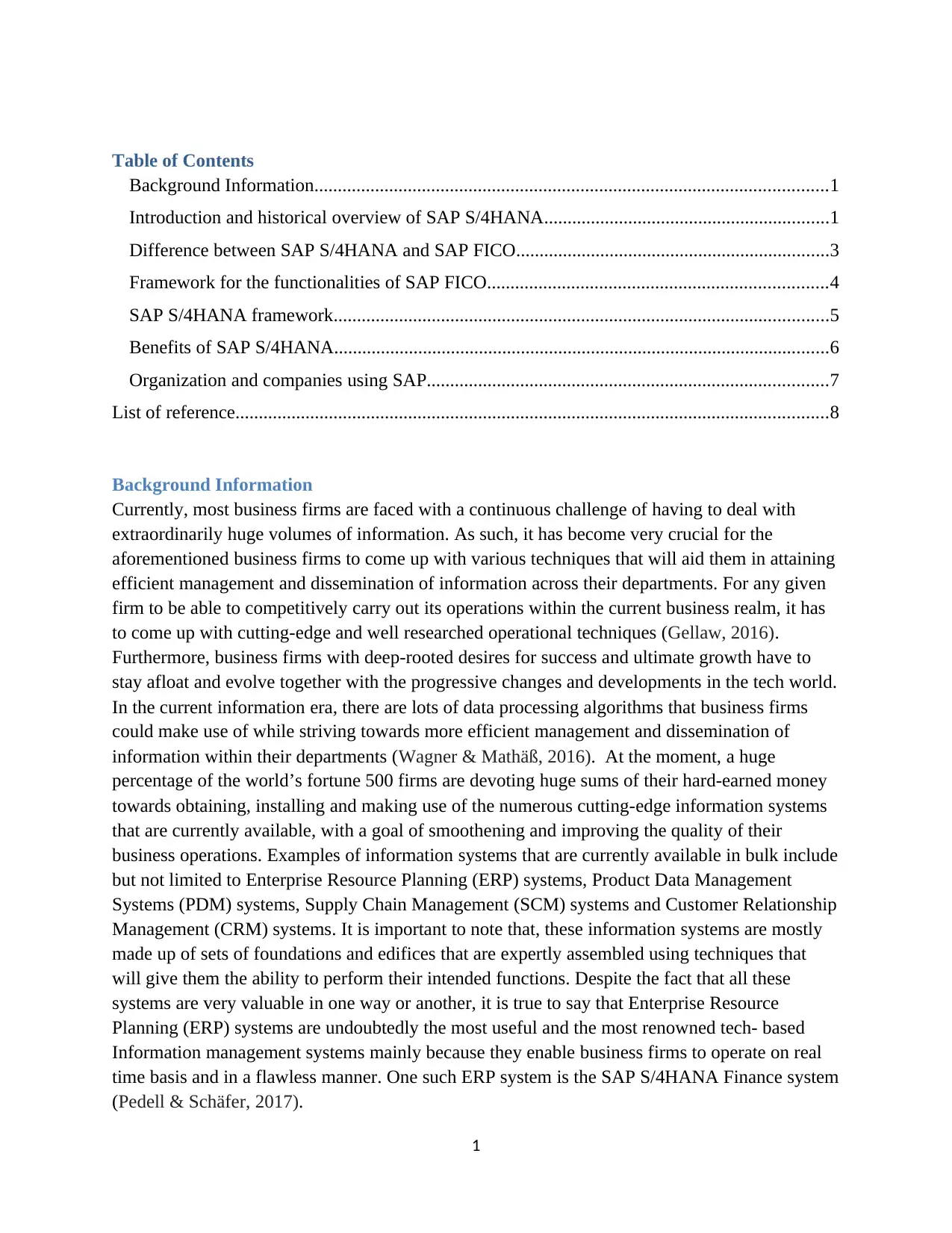
Table of Contents
Background Information..............................................................................................................1
Introduction and historical overview of SAP S/4HANA.............................................................1
Difference between SAP S/4HANA and SAP FICO...................................................................3
Framework for the functionalities of SAP FICO.........................................................................4
SAP S/4HANA framework..........................................................................................................5
Benefits of SAP S/4HANA..........................................................................................................6
Organization and companies using SAP......................................................................................7
List of reference...............................................................................................................................8
Background Information
Currently, most business firms are faced with a continuous challenge of having to deal with
extraordinarily huge volumes of information. As such, it has become very crucial for the
aforementioned business firms to come up with various techniques that will aid them in attaining
efficient management and dissemination of information across their departments. For any given
firm to be able to competitively carry out its operations within the current business realm, it has
to come up with cutting-edge and well researched operational techniques (Gellaw, 2016).
Furthermore, business firms with deep-rooted desires for success and ultimate growth have to
stay afloat and evolve together with the progressive changes and developments in the tech world.
In the current information era, there are lots of data processing algorithms that business firms
could make use of while striving towards more efficient management and dissemination of
information within their departments (Wagner & Mathäß, 2016). At the moment, a huge
percentage of the world’s fortune 500 firms are devoting huge sums of their hard-earned money
towards obtaining, installing and making use of the numerous cutting-edge information systems
that are currently available, with a goal of smoothening and improving the quality of their
business operations. Examples of information systems that are currently available in bulk include
but not limited to Enterprise Resource Planning (ERP) systems, Product Data Management
Systems (PDM) systems, Supply Chain Management (SCM) systems and Customer Relationship
Management (CRM) systems. It is important to note that, these information systems are mostly
made up of sets of foundations and edifices that are expertly assembled using techniques that
will give them the ability to perform their intended functions. Despite the fact that all these
systems are very valuable in one way or another, it is true to say that Enterprise Resource
Planning (ERP) systems are undoubtedly the most useful and the most renowned tech- based
Information management systems mainly because they enable business firms to operate on real
time basis and in a flawless manner. One such ERP system is the SAP S/4HANA Finance system
(Pedell & Schäfer, 2017).
1
Background Information..............................................................................................................1
Introduction and historical overview of SAP S/4HANA.............................................................1
Difference between SAP S/4HANA and SAP FICO...................................................................3
Framework for the functionalities of SAP FICO.........................................................................4
SAP S/4HANA framework..........................................................................................................5
Benefits of SAP S/4HANA..........................................................................................................6
Organization and companies using SAP......................................................................................7
List of reference...............................................................................................................................8
Background Information
Currently, most business firms are faced with a continuous challenge of having to deal with
extraordinarily huge volumes of information. As such, it has become very crucial for the
aforementioned business firms to come up with various techniques that will aid them in attaining
efficient management and dissemination of information across their departments. For any given
firm to be able to competitively carry out its operations within the current business realm, it has
to come up with cutting-edge and well researched operational techniques (Gellaw, 2016).
Furthermore, business firms with deep-rooted desires for success and ultimate growth have to
stay afloat and evolve together with the progressive changes and developments in the tech world.
In the current information era, there are lots of data processing algorithms that business firms
could make use of while striving towards more efficient management and dissemination of
information within their departments (Wagner & Mathäß, 2016). At the moment, a huge
percentage of the world’s fortune 500 firms are devoting huge sums of their hard-earned money
towards obtaining, installing and making use of the numerous cutting-edge information systems
that are currently available, with a goal of smoothening and improving the quality of their
business operations. Examples of information systems that are currently available in bulk include
but not limited to Enterprise Resource Planning (ERP) systems, Product Data Management
Systems (PDM) systems, Supply Chain Management (SCM) systems and Customer Relationship
Management (CRM) systems. It is important to note that, these information systems are mostly
made up of sets of foundations and edifices that are expertly assembled using techniques that
will give them the ability to perform their intended functions. Despite the fact that all these
systems are very valuable in one way or another, it is true to say that Enterprise Resource
Planning (ERP) systems are undoubtedly the most useful and the most renowned tech- based
Information management systems mainly because they enable business firms to operate on real
time basis and in a flawless manner. One such ERP system is the SAP S/4HANA Finance system
(Pedell & Schäfer, 2017).
1
Paraphrase This Document
Need a fresh take? Get an instant paraphrase of this document with our AI Paraphraser
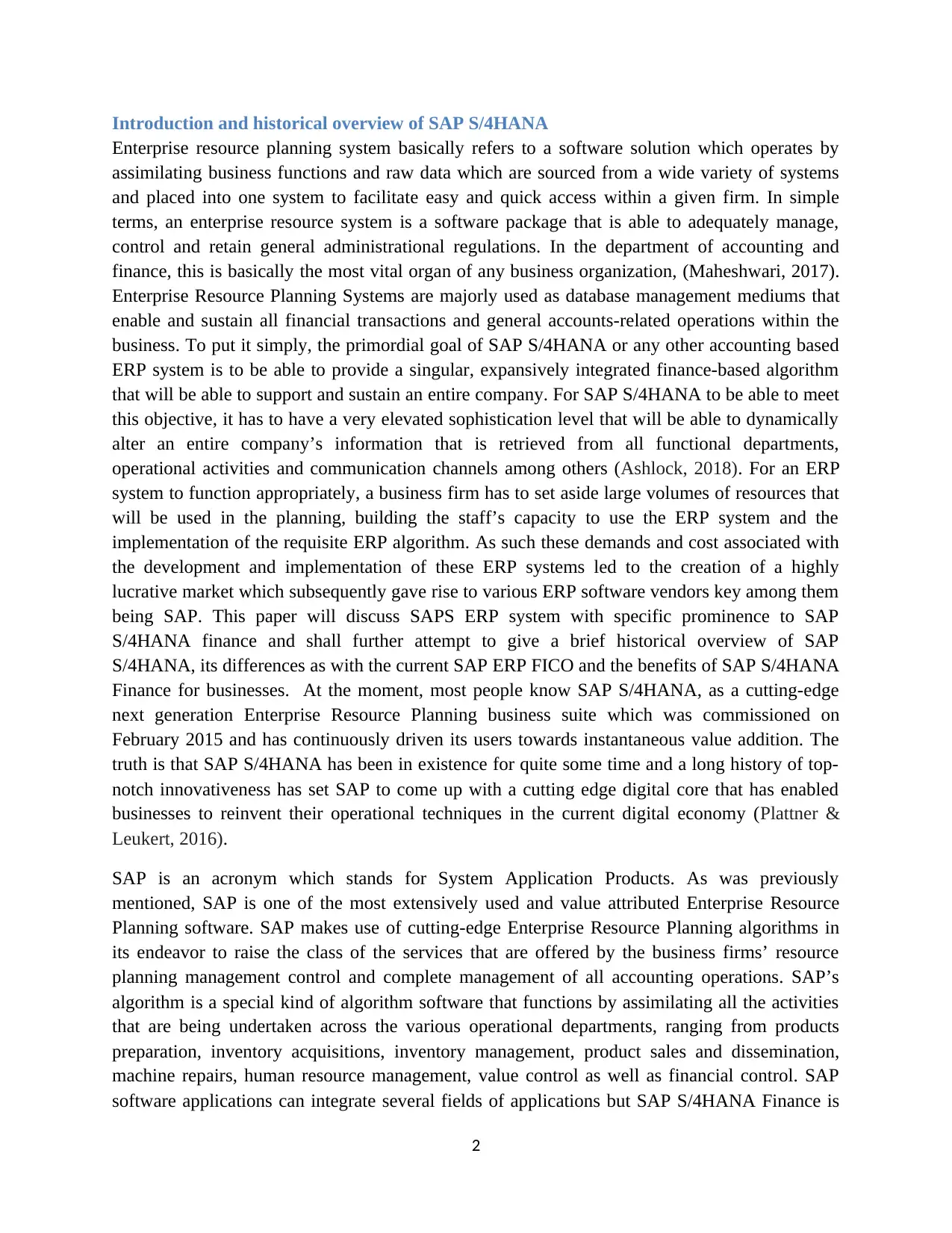
Introduction and historical overview of SAP S/4HANA
Enterprise resource planning system basically refers to a software solution which operates by
assimilating business functions and raw data which are sourced from a wide variety of systems
and placed into one system to facilitate easy and quick access within a given firm. In simple
terms, an enterprise resource system is a software package that is able to adequately manage,
control and retain general administrational regulations. In the department of accounting and
finance, this is basically the most vital organ of any business organization, (Maheshwari, 2017).
Enterprise Resource Planning Systems are majorly used as database management mediums that
enable and sustain all financial transactions and general accounts-related operations within the
business. To put it simply, the primordial goal of SAP S/4HANA or any other accounting based
ERP system is to be able to provide a singular, expansively integrated finance-based algorithm
that will be able to support and sustain an entire company. For SAP S/4HANA to be able to meet
this objective, it has to have a very elevated sophistication level that will be able to dynamically
alter an entire company’s information that is retrieved from all functional departments,
operational activities and communication channels among others (Ashlock, 2018). For an ERP
system to function appropriately, a business firm has to set aside large volumes of resources that
will be used in the planning, building the staff’s capacity to use the ERP system and the
implementation of the requisite ERP algorithm. As such these demands and cost associated with
the development and implementation of these ERP systems led to the creation of a highly
lucrative market which subsequently gave rise to various ERP software vendors key among them
being SAP. This paper will discuss SAPS ERP system with specific prominence to SAP
S/4HANA finance and shall further attempt to give a brief historical overview of SAP
S/4HANA, its differences as with the current SAP ERP FICO and the benefits of SAP S/4HANA
Finance for businesses. At the moment, most people know SAP S/4HANA, as a cutting-edge
next generation Enterprise Resource Planning business suite which was commissioned on
February 2015 and has continuously driven its users towards instantaneous value addition. The
truth is that SAP S/4HANA has been in existence for quite some time and a long history of top-
notch innovativeness has set SAP to come up with a cutting edge digital core that has enabled
businesses to reinvent their operational techniques in the current digital economy (Plattner &
Leukert, 2016).
SAP is an acronym which stands for System Application Products. As was previously
mentioned, SAP is one of the most extensively used and value attributed Enterprise Resource
Planning software. SAP makes use of cutting-edge Enterprise Resource Planning algorithms in
its endeavor to raise the class of the services that are offered by the business firms’ resource
planning management control and complete management of all accounting operations. SAP’s
algorithm is a special kind of algorithm software that functions by assimilating all the activities
that are being undertaken across the various operational departments, ranging from products
preparation, inventory acquisitions, inventory management, product sales and dissemination,
machine repairs, human resource management, value control as well as financial control. SAP
software applications can integrate several fields of applications but SAP S/4HANA Finance is
2
Enterprise resource planning system basically refers to a software solution which operates by
assimilating business functions and raw data which are sourced from a wide variety of systems
and placed into one system to facilitate easy and quick access within a given firm. In simple
terms, an enterprise resource system is a software package that is able to adequately manage,
control and retain general administrational regulations. In the department of accounting and
finance, this is basically the most vital organ of any business organization, (Maheshwari, 2017).
Enterprise Resource Planning Systems are majorly used as database management mediums that
enable and sustain all financial transactions and general accounts-related operations within the
business. To put it simply, the primordial goal of SAP S/4HANA or any other accounting based
ERP system is to be able to provide a singular, expansively integrated finance-based algorithm
that will be able to support and sustain an entire company. For SAP S/4HANA to be able to meet
this objective, it has to have a very elevated sophistication level that will be able to dynamically
alter an entire company’s information that is retrieved from all functional departments,
operational activities and communication channels among others (Ashlock, 2018). For an ERP
system to function appropriately, a business firm has to set aside large volumes of resources that
will be used in the planning, building the staff’s capacity to use the ERP system and the
implementation of the requisite ERP algorithm. As such these demands and cost associated with
the development and implementation of these ERP systems led to the creation of a highly
lucrative market which subsequently gave rise to various ERP software vendors key among them
being SAP. This paper will discuss SAPS ERP system with specific prominence to SAP
S/4HANA finance and shall further attempt to give a brief historical overview of SAP
S/4HANA, its differences as with the current SAP ERP FICO and the benefits of SAP S/4HANA
Finance for businesses. At the moment, most people know SAP S/4HANA, as a cutting-edge
next generation Enterprise Resource Planning business suite which was commissioned on
February 2015 and has continuously driven its users towards instantaneous value addition. The
truth is that SAP S/4HANA has been in existence for quite some time and a long history of top-
notch innovativeness has set SAP to come up with a cutting edge digital core that has enabled
businesses to reinvent their operational techniques in the current digital economy (Plattner &
Leukert, 2016).
SAP is an acronym which stands for System Application Products. As was previously
mentioned, SAP is one of the most extensively used and value attributed Enterprise Resource
Planning software. SAP makes use of cutting-edge Enterprise Resource Planning algorithms in
its endeavor to raise the class of the services that are offered by the business firms’ resource
planning management control and complete management of all accounting operations. SAP’s
algorithm is a special kind of algorithm software that functions by assimilating all the activities
that are being undertaken across the various operational departments, ranging from products
preparation, inventory acquisitions, inventory management, product sales and dissemination,
machine repairs, human resource management, value control as well as financial control. SAP
software applications can integrate several fields of applications but SAP S/4HANA Finance is
2
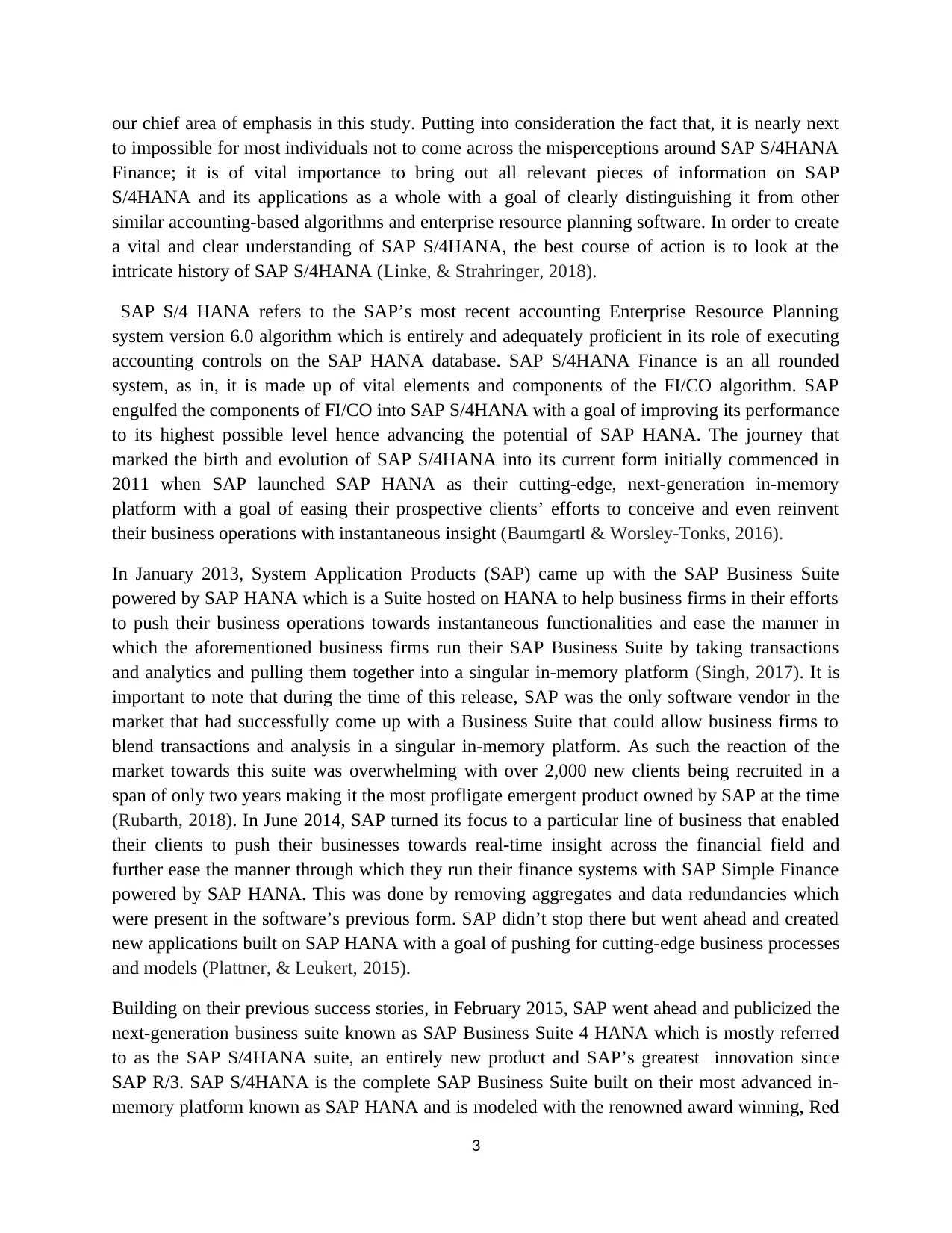
our chief area of emphasis in this study. Putting into consideration the fact that, it is nearly next
to impossible for most individuals not to come across the misperceptions around SAP S/4HANA
Finance; it is of vital importance to bring out all relevant pieces of information on SAP
S/4HANA and its applications as a whole with a goal of clearly distinguishing it from other
similar accounting-based algorithms and enterprise resource planning software. In order to create
a vital and clear understanding of SAP S/4HANA, the best course of action is to look at the
intricate history of SAP S/4HANA (Linke, & Strahringer, 2018).
SAP S/4 HANA refers to the SAP’s most recent accounting Enterprise Resource Planning
system version 6.0 algorithm which is entirely and adequately proficient in its role of executing
accounting controls on the SAP HANA database. SAP S/4HANA Finance is an all rounded
system, as in, it is made up of vital elements and components of the FI/CO algorithm. SAP
engulfed the components of FI/CO into SAP S/4HANA with a goal of improving its performance
to its highest possible level hence advancing the potential of SAP HANA. The journey that
marked the birth and evolution of SAP S/4HANA into its current form initially commenced in
2011 when SAP launched SAP HANA as their cutting-edge, next-generation in-memory
platform with a goal of easing their prospective clients’ efforts to conceive and even reinvent
their business operations with instantaneous insight (Baumgartl & Worsley-Tonks, 2016).
In January 2013, System Application Products (SAP) came up with the SAP Business Suite
powered by SAP HANA which is a Suite hosted on HANA to help business firms in their efforts
to push their business operations towards instantaneous functionalities and ease the manner in
which the aforementioned business firms run their SAP Business Suite by taking transactions
and analytics and pulling them together into a singular in-memory platform (Singh, 2017). It is
important to note that during the time of this release, SAP was the only software vendor in the
market that had successfully come up with a Business Suite that could allow business firms to
blend transactions and analysis in a singular in-memory platform. As such the reaction of the
market towards this suite was overwhelming with over 2,000 new clients being recruited in a
span of only two years making it the most profligate emergent product owned by SAP at the time
(Rubarth, 2018). In June 2014, SAP turned its focus to a particular line of business that enabled
their clients to push their businesses towards real-time insight across the financial field and
further ease the manner through which they run their finance systems with SAP Simple Finance
powered by SAP HANA. This was done by removing aggregates and data redundancies which
were present in the software’s previous form. SAP didn’t stop there but went ahead and created
new applications built on SAP HANA with a goal of pushing for cutting-edge business processes
and models (Plattner, & Leukert, 2015).
Building on their previous success stories, in February 2015, SAP went ahead and publicized the
next-generation business suite known as SAP Business Suite 4 HANA which is mostly referred
to as the SAP S/4HANA suite, an entirely new product and SAP’s greatest innovation since
SAP R/3. SAP S/4HANA is the complete SAP Business Suite built on their most advanced in-
memory platform known as SAP HANA and is modeled with the renowned award winning, Red
3
to impossible for most individuals not to come across the misperceptions around SAP S/4HANA
Finance; it is of vital importance to bring out all relevant pieces of information on SAP
S/4HANA and its applications as a whole with a goal of clearly distinguishing it from other
similar accounting-based algorithms and enterprise resource planning software. In order to create
a vital and clear understanding of SAP S/4HANA, the best course of action is to look at the
intricate history of SAP S/4HANA (Linke, & Strahringer, 2018).
SAP S/4 HANA refers to the SAP’s most recent accounting Enterprise Resource Planning
system version 6.0 algorithm which is entirely and adequately proficient in its role of executing
accounting controls on the SAP HANA database. SAP S/4HANA Finance is an all rounded
system, as in, it is made up of vital elements and components of the FI/CO algorithm. SAP
engulfed the components of FI/CO into SAP S/4HANA with a goal of improving its performance
to its highest possible level hence advancing the potential of SAP HANA. The journey that
marked the birth and evolution of SAP S/4HANA into its current form initially commenced in
2011 when SAP launched SAP HANA as their cutting-edge, next-generation in-memory
platform with a goal of easing their prospective clients’ efforts to conceive and even reinvent
their business operations with instantaneous insight (Baumgartl & Worsley-Tonks, 2016).
In January 2013, System Application Products (SAP) came up with the SAP Business Suite
powered by SAP HANA which is a Suite hosted on HANA to help business firms in their efforts
to push their business operations towards instantaneous functionalities and ease the manner in
which the aforementioned business firms run their SAP Business Suite by taking transactions
and analytics and pulling them together into a singular in-memory platform (Singh, 2017). It is
important to note that during the time of this release, SAP was the only software vendor in the
market that had successfully come up with a Business Suite that could allow business firms to
blend transactions and analysis in a singular in-memory platform. As such the reaction of the
market towards this suite was overwhelming with over 2,000 new clients being recruited in a
span of only two years making it the most profligate emergent product owned by SAP at the time
(Rubarth, 2018). In June 2014, SAP turned its focus to a particular line of business that enabled
their clients to push their businesses towards real-time insight across the financial field and
further ease the manner through which they run their finance systems with SAP Simple Finance
powered by SAP HANA. This was done by removing aggregates and data redundancies which
were present in the software’s previous form. SAP didn’t stop there but went ahead and created
new applications built on SAP HANA with a goal of pushing for cutting-edge business processes
and models (Plattner, & Leukert, 2015).
Building on their previous success stories, in February 2015, SAP went ahead and publicized the
next-generation business suite known as SAP Business Suite 4 HANA which is mostly referred
to as the SAP S/4HANA suite, an entirely new product and SAP’s greatest innovation since
SAP R/3. SAP S/4HANA is the complete SAP Business Suite built on their most advanced in-
memory platform known as SAP HANA and is modeled with the renowned award winning, Red
3
⊘ This is a preview!⊘
Do you want full access?
Subscribe today to unlock all pages.

Trusted by 1+ million students worldwide
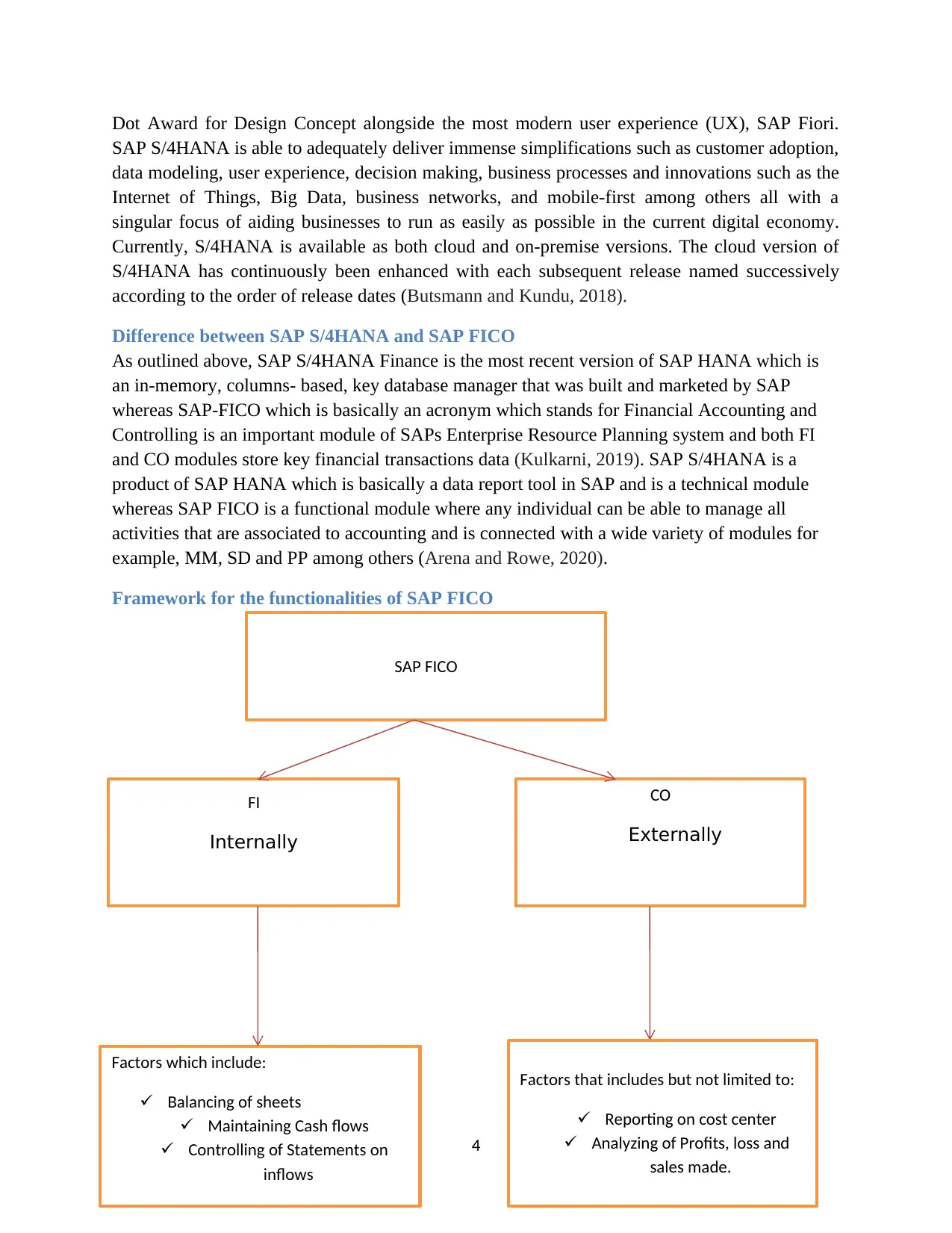
Dot Award for Design Concept alongside the most modern user experience (UX), SAP Fiori.
SAP S/4HANA is able to adequately deliver immense simplifications such as customer adoption,
data modeling, user experience, decision making, business processes and innovations such as the
Internet of Things, Big Data, business networks, and mobile-first among others all with a
singular focus of aiding businesses to run as easily as possible in the current digital economy.
Currently, S/4HANA is available as both cloud and on-premise versions. The cloud version of
S/4HANA has continuously been enhanced with each subsequent release named successively
according to the order of release dates (Butsmann and Kundu, 2018).
Difference between SAP S/4HANA and SAP FICO
As outlined above, SAP S/4HANA Finance is the most recent version of SAP HANA which is
an in-memory, columns- based, key database manager that was built and marketed by SAP
whereas SAP-FICO which is basically an acronym which stands for Financial Accounting and
Controlling is an important module of SAPs Enterprise Resource Planning system and both FI
and CO modules store key financial transactions data (Kulkarni, 2019). SAP S/4HANA is a
product of SAP HANA which is basically a data report tool in SAP and is a technical module
whereas SAP FICO is a functional module where any individual can be able to manage all
activities that are associated to accounting and is connected with a wide variety of modules for
example, MM, SD and PP among others (Arena and Rowe, 2020).
Framework for the functionalities of SAP FICO
4
FI
Internally
CO
Externally
Factors which include:
Balancing of sheets
Maintaining Cash flows
Controlling of Statements on
inflows
Factors that includes but not limited to:
Reporting on cost center
Analyzing of Profits, loss and
sales made.
SAP FICO
SAP S/4HANA is able to adequately deliver immense simplifications such as customer adoption,
data modeling, user experience, decision making, business processes and innovations such as the
Internet of Things, Big Data, business networks, and mobile-first among others all with a
singular focus of aiding businesses to run as easily as possible in the current digital economy.
Currently, S/4HANA is available as both cloud and on-premise versions. The cloud version of
S/4HANA has continuously been enhanced with each subsequent release named successively
according to the order of release dates (Butsmann and Kundu, 2018).
Difference between SAP S/4HANA and SAP FICO
As outlined above, SAP S/4HANA Finance is the most recent version of SAP HANA which is
an in-memory, columns- based, key database manager that was built and marketed by SAP
whereas SAP-FICO which is basically an acronym which stands for Financial Accounting and
Controlling is an important module of SAPs Enterprise Resource Planning system and both FI
and CO modules store key financial transactions data (Kulkarni, 2019). SAP S/4HANA is a
product of SAP HANA which is basically a data report tool in SAP and is a technical module
whereas SAP FICO is a functional module where any individual can be able to manage all
activities that are associated to accounting and is connected with a wide variety of modules for
example, MM, SD and PP among others (Arena and Rowe, 2020).
Framework for the functionalities of SAP FICO
4
FI
Internally
CO
Externally
Factors which include:
Balancing of sheets
Maintaining Cash flows
Controlling of Statements on
inflows
Factors that includes but not limited to:
Reporting on cost center
Analyzing of Profits, loss and
sales made.
SAP FICO
Paraphrase This Document
Need a fresh take? Get an instant paraphrase of this document with our AI Paraphraser
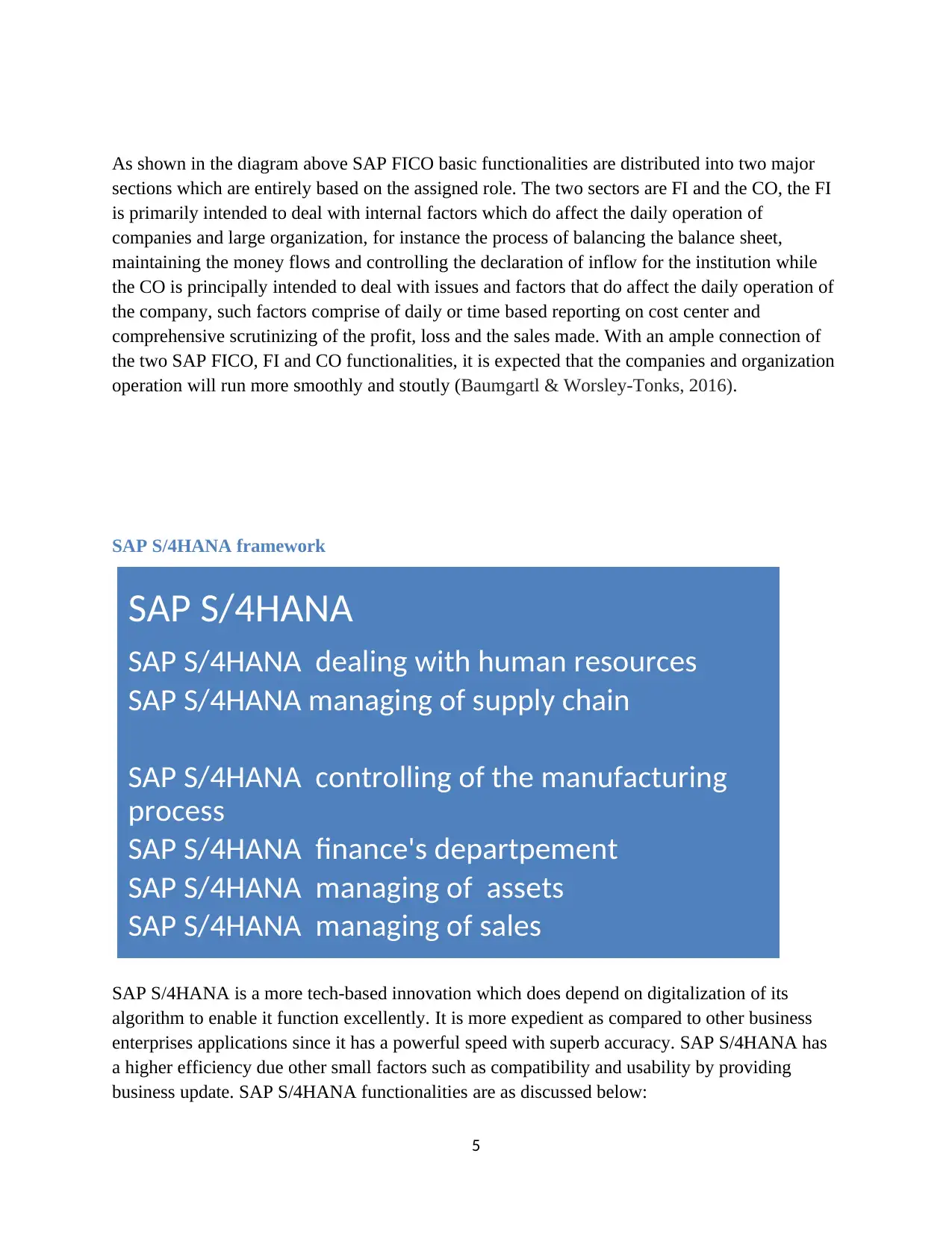
As shown in the diagram above SAP FICO basic functionalities are distributed into two major
sections which are entirely based on the assigned role. The two sectors are FI and the CO, the FI
is primarily intended to deal with internal factors which do affect the daily operation of
companies and large organization, for instance the process of balancing the balance sheet,
maintaining the money flows and controlling the declaration of inflow for the institution while
the CO is principally intended to deal with issues and factors that do affect the daily operation of
the company, such factors comprise of daily or time based reporting on cost center and
comprehensive scrutinizing of the profit, loss and the sales made. With an ample connection of
the two SAP FICO, FI and CO functionalities, it is expected that the companies and organization
operation will run more smoothly and stoutly (Baumgartl & Worsley-Tonks, 2016).
SAP S/4HANA framework
SAP S/4HANA is a more tech-based innovation which does depend on digitalization of its
algorithm to enable it function excellently. It is more expedient as compared to other business
enterprises applications since it has a powerful speed with superb accuracy. SAP S/4HANA has
a higher efficiency due other small factors such as compatibility and usability by providing
business update. SAP S/4HANA functionalities are as discussed below:
5
SAP S/4HANA
SAP S/4HANA dealing with human resources
SAP S/4HANA managing of supply chain
SAP S/4HANA controlling of the manufacturing
process
SAP S/4HANA finance's departpement
SAP S/4HANA managing of assets
SAP S/4HANA managing of sales
sections which are entirely based on the assigned role. The two sectors are FI and the CO, the FI
is primarily intended to deal with internal factors which do affect the daily operation of
companies and large organization, for instance the process of balancing the balance sheet,
maintaining the money flows and controlling the declaration of inflow for the institution while
the CO is principally intended to deal with issues and factors that do affect the daily operation of
the company, such factors comprise of daily or time based reporting on cost center and
comprehensive scrutinizing of the profit, loss and the sales made. With an ample connection of
the two SAP FICO, FI and CO functionalities, it is expected that the companies and organization
operation will run more smoothly and stoutly (Baumgartl & Worsley-Tonks, 2016).
SAP S/4HANA framework
SAP S/4HANA is a more tech-based innovation which does depend on digitalization of its
algorithm to enable it function excellently. It is more expedient as compared to other business
enterprises applications since it has a powerful speed with superb accuracy. SAP S/4HANA has
a higher efficiency due other small factors such as compatibility and usability by providing
business update. SAP S/4HANA functionalities are as discussed below:
5
SAP S/4HANA
SAP S/4HANA dealing with human resources
SAP S/4HANA managing of supply chain
SAP S/4HANA controlling of the manufacturing
process
SAP S/4HANA finance's departpement
SAP S/4HANA managing of assets
SAP S/4HANA managing of sales
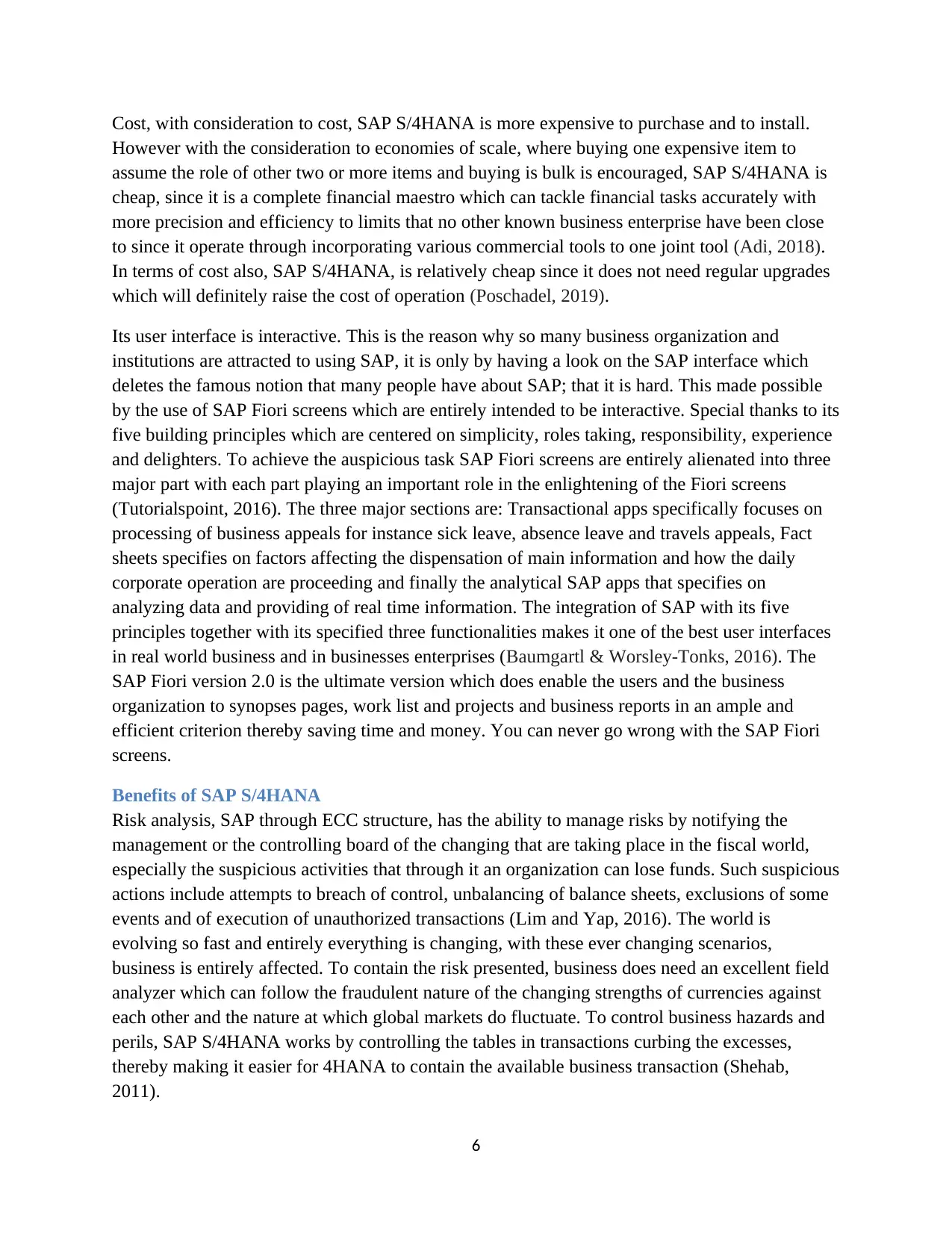
Cost, with consideration to cost, SAP S/4HANA is more expensive to purchase and to install.
However with the consideration to economies of scale, where buying one expensive item to
assume the role of other two or more items and buying is bulk is encouraged, SAP S/4HANA is
cheap, since it is a complete financial maestro which can tackle financial tasks accurately with
more precision and efficiency to limits that no other known business enterprise have been close
to since it operate through incorporating various commercial tools to one joint tool (Adi, 2018).
In terms of cost also, SAP S/4HANA, is relatively cheap since it does not need regular upgrades
which will definitely raise the cost of operation (Poschadel, 2019).
Its user interface is interactive. This is the reason why so many business organization and
institutions are attracted to using SAP, it is only by having a look on the SAP interface which
deletes the famous notion that many people have about SAP; that it is hard. This made possible
by the use of SAP Fiori screens which are entirely intended to be interactive. Special thanks to its
five building principles which are centered on simplicity, roles taking, responsibility, experience
and delighters. To achieve the auspicious task SAP Fiori screens are entirely alienated into three
major part with each part playing an important role in the enlightening of the Fiori screens
(Tutorialspoint, 2016). The three major sections are: Transactional apps specifically focuses on
processing of business appeals for instance sick leave, absence leave and travels appeals, Fact
sheets specifies on factors affecting the dispensation of main information and how the daily
corporate operation are proceeding and finally the analytical SAP apps that specifies on
analyzing data and providing of real time information. The integration of SAP with its five
principles together with its specified three functionalities makes it one of the best user interfaces
in real world business and in businesses enterprises (Baumgartl & Worsley-Tonks, 2016). The
SAP Fiori version 2.0 is the ultimate version which does enable the users and the business
organization to synopses pages, work list and projects and business reports in an ample and
efficient criterion thereby saving time and money. You can never go wrong with the SAP Fiori
screens.
Benefits of SAP S/4HANA
Risk analysis, SAP through ECC structure, has the ability to manage risks by notifying the
management or the controlling board of the changing that are taking place in the fiscal world,
especially the suspicious activities that through it an organization can lose funds. Such suspicious
actions include attempts to breach of control, unbalancing of balance sheets, exclusions of some
events and of execution of unauthorized transactions (Lim and Yap, 2016). The world is
evolving so fast and entirely everything is changing, with these ever changing scenarios,
business is entirely affected. To contain the risk presented, business does need an excellent field
analyzer which can follow the fraudulent nature of the changing strengths of currencies against
each other and the nature at which global markets do fluctuate. To control business hazards and
perils, SAP S/4HANA works by controlling the tables in transactions curbing the excesses,
thereby making it easier for 4HANA to contain the available business transaction (Shehab,
2011).
6
However with the consideration to economies of scale, where buying one expensive item to
assume the role of other two or more items and buying is bulk is encouraged, SAP S/4HANA is
cheap, since it is a complete financial maestro which can tackle financial tasks accurately with
more precision and efficiency to limits that no other known business enterprise have been close
to since it operate through incorporating various commercial tools to one joint tool (Adi, 2018).
In terms of cost also, SAP S/4HANA, is relatively cheap since it does not need regular upgrades
which will definitely raise the cost of operation (Poschadel, 2019).
Its user interface is interactive. This is the reason why so many business organization and
institutions are attracted to using SAP, it is only by having a look on the SAP interface which
deletes the famous notion that many people have about SAP; that it is hard. This made possible
by the use of SAP Fiori screens which are entirely intended to be interactive. Special thanks to its
five building principles which are centered on simplicity, roles taking, responsibility, experience
and delighters. To achieve the auspicious task SAP Fiori screens are entirely alienated into three
major part with each part playing an important role in the enlightening of the Fiori screens
(Tutorialspoint, 2016). The three major sections are: Transactional apps specifically focuses on
processing of business appeals for instance sick leave, absence leave and travels appeals, Fact
sheets specifies on factors affecting the dispensation of main information and how the daily
corporate operation are proceeding and finally the analytical SAP apps that specifies on
analyzing data and providing of real time information. The integration of SAP with its five
principles together with its specified three functionalities makes it one of the best user interfaces
in real world business and in businesses enterprises (Baumgartl & Worsley-Tonks, 2016). The
SAP Fiori version 2.0 is the ultimate version which does enable the users and the business
organization to synopses pages, work list and projects and business reports in an ample and
efficient criterion thereby saving time and money. You can never go wrong with the SAP Fiori
screens.
Benefits of SAP S/4HANA
Risk analysis, SAP through ECC structure, has the ability to manage risks by notifying the
management or the controlling board of the changing that are taking place in the fiscal world,
especially the suspicious activities that through it an organization can lose funds. Such suspicious
actions include attempts to breach of control, unbalancing of balance sheets, exclusions of some
events and of execution of unauthorized transactions (Lim and Yap, 2016). The world is
evolving so fast and entirely everything is changing, with these ever changing scenarios,
business is entirely affected. To contain the risk presented, business does need an excellent field
analyzer which can follow the fraudulent nature of the changing strengths of currencies against
each other and the nature at which global markets do fluctuate. To control business hazards and
perils, SAP S/4HANA works by controlling the tables in transactions curbing the excesses,
thereby making it easier for 4HANA to contain the available business transaction (Shehab,
2011).
6
⊘ This is a preview!⊘
Do you want full access?
Subscribe today to unlock all pages.

Trusted by 1+ million students worldwide
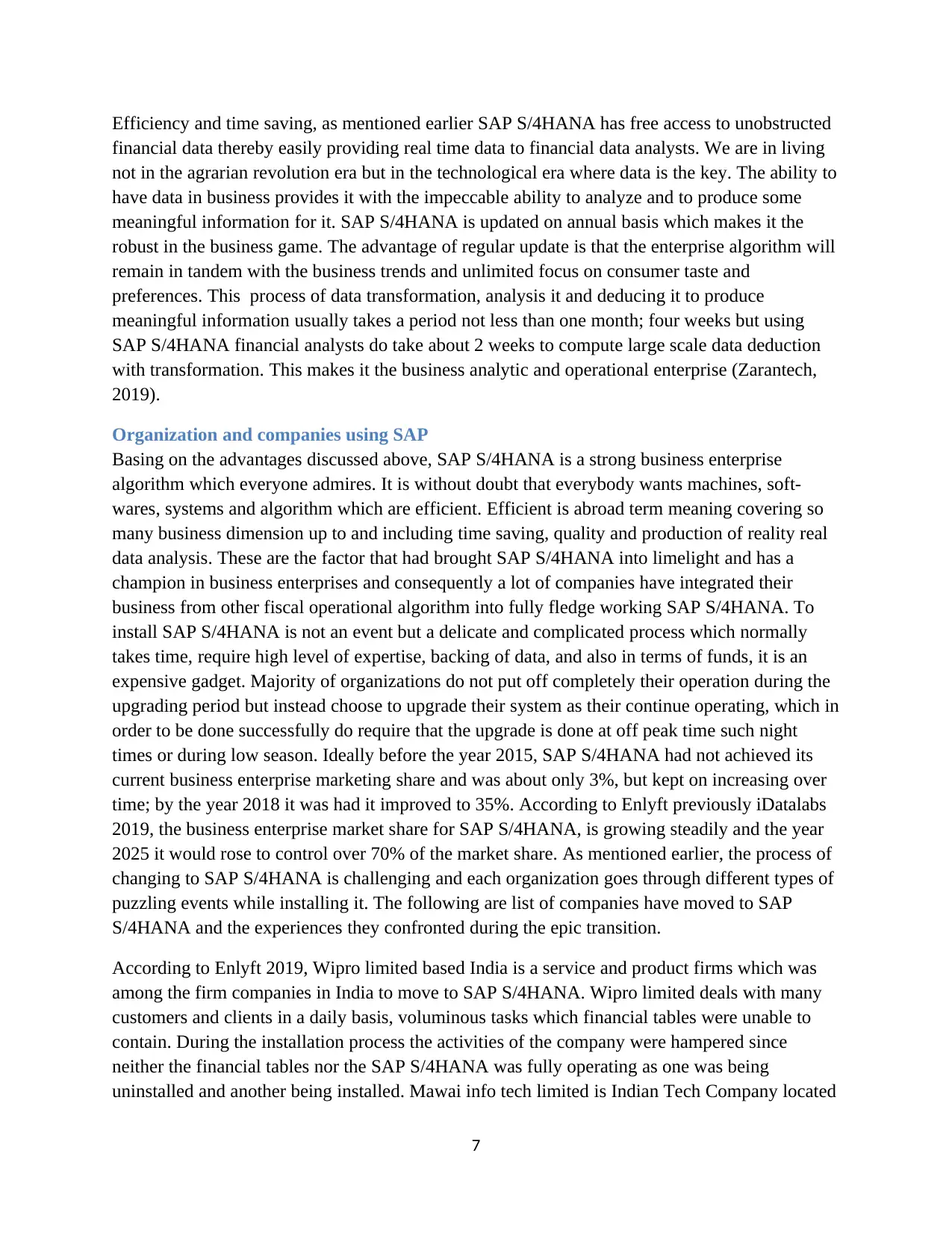
Efficiency and time saving, as mentioned earlier SAP S/4HANA has free access to unobstructed
financial data thereby easily providing real time data to financial data analysts. We are in living
not in the agrarian revolution era but in the technological era where data is the key. The ability to
have data in business provides it with the impeccable ability to analyze and to produce some
meaningful information for it. SAP S/4HANA is updated on annual basis which makes it the
robust in the business game. The advantage of regular update is that the enterprise algorithm will
remain in tandem with the business trends and unlimited focus on consumer taste and
preferences. This process of data transformation, analysis it and deducing it to produce
meaningful information usually takes a period not less than one month; four weeks but using
SAP S/4HANA financial analysts do take about 2 weeks to compute large scale data deduction
with transformation. This makes it the business analytic and operational enterprise (Zarantech,
2019).
Organization and companies using SAP
Basing on the advantages discussed above, SAP S/4HANA is a strong business enterprise
algorithm which everyone admires. It is without doubt that everybody wants machines, soft-
wares, systems and algorithm which are efficient. Efficient is abroad term meaning covering so
many business dimension up to and including time saving, quality and production of reality real
data analysis. These are the factor that had brought SAP S/4HANA into limelight and has a
champion in business enterprises and consequently a lot of companies have integrated their
business from other fiscal operational algorithm into fully fledge working SAP S/4HANA. To
install SAP S/4HANA is not an event but a delicate and complicated process which normally
takes time, require high level of expertise, backing of data, and also in terms of funds, it is an
expensive gadget. Majority of organizations do not put off completely their operation during the
upgrading period but instead choose to upgrade their system as their continue operating, which in
order to be done successfully do require that the upgrade is done at off peak time such night
times or during low season. Ideally before the year 2015, SAP S/4HANA had not achieved its
current business enterprise marketing share and was about only 3%, but kept on increasing over
time; by the year 2018 it was had it improved to 35%. According to Enlyft previously iDatalabs
2019, the business enterprise market share for SAP S/4HANA, is growing steadily and the year
2025 it would rose to control over 70% of the market share. As mentioned earlier, the process of
changing to SAP S/4HANA is challenging and each organization goes through different types of
puzzling events while installing it. The following are list of companies have moved to SAP
S/4HANA and the experiences they confronted during the epic transition.
According to Enlyft 2019, Wipro limited based India is a service and product firms which was
among the firm companies in India to move to SAP S/4HANA. Wipro limited deals with many
customers and clients in a daily basis, voluminous tasks which financial tables were unable to
contain. During the installation process the activities of the company were hampered since
neither the financial tables nor the SAP S/4HANA was fully operating as one was being
uninstalled and another being installed. Mawai info tech limited is Indian Tech Company located
7
financial data thereby easily providing real time data to financial data analysts. We are in living
not in the agrarian revolution era but in the technological era where data is the key. The ability to
have data in business provides it with the impeccable ability to analyze and to produce some
meaningful information for it. SAP S/4HANA is updated on annual basis which makes it the
robust in the business game. The advantage of regular update is that the enterprise algorithm will
remain in tandem with the business trends and unlimited focus on consumer taste and
preferences. This process of data transformation, analysis it and deducing it to produce
meaningful information usually takes a period not less than one month; four weeks but using
SAP S/4HANA financial analysts do take about 2 weeks to compute large scale data deduction
with transformation. This makes it the business analytic and operational enterprise (Zarantech,
2019).
Organization and companies using SAP
Basing on the advantages discussed above, SAP S/4HANA is a strong business enterprise
algorithm which everyone admires. It is without doubt that everybody wants machines, soft-
wares, systems and algorithm which are efficient. Efficient is abroad term meaning covering so
many business dimension up to and including time saving, quality and production of reality real
data analysis. These are the factor that had brought SAP S/4HANA into limelight and has a
champion in business enterprises and consequently a lot of companies have integrated their
business from other fiscal operational algorithm into fully fledge working SAP S/4HANA. To
install SAP S/4HANA is not an event but a delicate and complicated process which normally
takes time, require high level of expertise, backing of data, and also in terms of funds, it is an
expensive gadget. Majority of organizations do not put off completely their operation during the
upgrading period but instead choose to upgrade their system as their continue operating, which in
order to be done successfully do require that the upgrade is done at off peak time such night
times or during low season. Ideally before the year 2015, SAP S/4HANA had not achieved its
current business enterprise marketing share and was about only 3%, but kept on increasing over
time; by the year 2018 it was had it improved to 35%. According to Enlyft previously iDatalabs
2019, the business enterprise market share for SAP S/4HANA, is growing steadily and the year
2025 it would rose to control over 70% of the market share. As mentioned earlier, the process of
changing to SAP S/4HANA is challenging and each organization goes through different types of
puzzling events while installing it. The following are list of companies have moved to SAP
S/4HANA and the experiences they confronted during the epic transition.
According to Enlyft 2019, Wipro limited based India is a service and product firms which was
among the firm companies in India to move to SAP S/4HANA. Wipro limited deals with many
customers and clients in a daily basis, voluminous tasks which financial tables were unable to
contain. During the installation process the activities of the company were hampered since
neither the financial tables nor the SAP S/4HANA was fully operating as one was being
uninstalled and another being installed. Mawai info tech limited is Indian Tech Company located
7
Paraphrase This Document
Need a fresh take? Get an instant paraphrase of this document with our AI Paraphraser
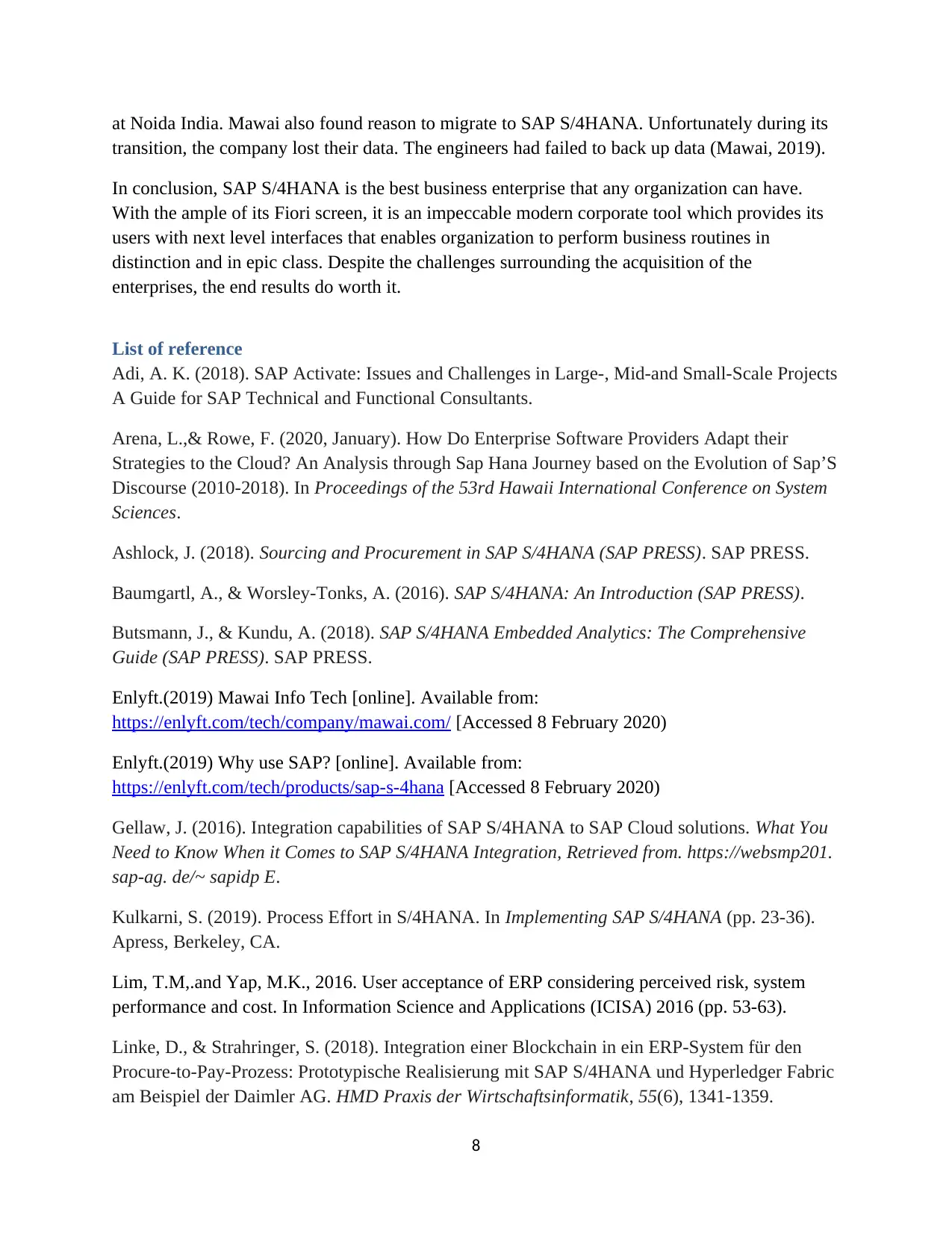
at Noida India. Mawai also found reason to migrate to SAP S/4HANA. Unfortunately during its
transition, the company lost their data. The engineers had failed to back up data (Mawai, 2019).
In conclusion, SAP S/4HANA is the best business enterprise that any organization can have.
With the ample of its Fiori screen, it is an impeccable modern corporate tool which provides its
users with next level interfaces that enables organization to perform business routines in
distinction and in epic class. Despite the challenges surrounding the acquisition of the
enterprises, the end results do worth it.
List of reference
Adi, A. K. (2018). SAP Activate: Issues and Challenges in Large-, Mid-and Small-Scale Projects
A Guide for SAP Technical and Functional Consultants.
Arena, L.,& Rowe, F. (2020, January). How Do Enterprise Software Providers Adapt their
Strategies to the Cloud? An Analysis through Sap Hana Journey based on the Evolution of Sap’S
Discourse (2010-2018). In Proceedings of the 53rd Hawaii International Conference on System
Sciences.
Ashlock, J. (2018). Sourcing and Procurement in SAP S/4HANA (SAP PRESS). SAP PRESS.
Baumgartl, A., & Worsley-Tonks, A. (2016). SAP S/4HANA: An Introduction (SAP PRESS).
Butsmann, J., & Kundu, A. (2018). SAP S/4HANA Embedded Analytics: The Comprehensive
Guide (SAP PRESS). SAP PRESS.
Enlyft.(2019) Mawai Info Tech [online]. Available from:
https://enlyft.com/tech/company/mawai.com/ [Accessed 8 February 2020)
Enlyft.(2019) Why use SAP? [online]. Available from:
https://enlyft.com/tech/products/sap-s-4hana [Accessed 8 February 2020)
Gellaw, J. (2016). Integration capabilities of SAP S/4HANA to SAP Cloud solutions. What You
Need to Know When it Comes to SAP S/4HANA Integration, Retrieved from. https://websmp201.
sap-ag. de/~ sapidp E.
Kulkarni, S. (2019). Process Effort in S/4HANA. In Implementing SAP S/4HANA (pp. 23-36).
Apress, Berkeley, CA.
Lim, T.M,.and Yap, M.K., 2016. User acceptance of ERP considering perceived risk, system
performance and cost. In Information Science and Applications (ICISA) 2016 (pp. 53-63).
Linke, D., & Strahringer, S. (2018). Integration einer Blockchain in ein ERP-System für den
Procure-to-Pay-Prozess: Prototypische Realisierung mit SAP S/4HANA und Hyperledger Fabric
am Beispiel der Daimler AG. HMD Praxis der Wirtschaftsinformatik, 55(6), 1341-1359.
8
transition, the company lost their data. The engineers had failed to back up data (Mawai, 2019).
In conclusion, SAP S/4HANA is the best business enterprise that any organization can have.
With the ample of its Fiori screen, it is an impeccable modern corporate tool which provides its
users with next level interfaces that enables organization to perform business routines in
distinction and in epic class. Despite the challenges surrounding the acquisition of the
enterprises, the end results do worth it.
List of reference
Adi, A. K. (2018). SAP Activate: Issues and Challenges in Large-, Mid-and Small-Scale Projects
A Guide for SAP Technical and Functional Consultants.
Arena, L.,& Rowe, F. (2020, January). How Do Enterprise Software Providers Adapt their
Strategies to the Cloud? An Analysis through Sap Hana Journey based on the Evolution of Sap’S
Discourse (2010-2018). In Proceedings of the 53rd Hawaii International Conference on System
Sciences.
Ashlock, J. (2018). Sourcing and Procurement in SAP S/4HANA (SAP PRESS). SAP PRESS.
Baumgartl, A., & Worsley-Tonks, A. (2016). SAP S/4HANA: An Introduction (SAP PRESS).
Butsmann, J., & Kundu, A. (2018). SAP S/4HANA Embedded Analytics: The Comprehensive
Guide (SAP PRESS). SAP PRESS.
Enlyft.(2019) Mawai Info Tech [online]. Available from:
https://enlyft.com/tech/company/mawai.com/ [Accessed 8 February 2020)
Enlyft.(2019) Why use SAP? [online]. Available from:
https://enlyft.com/tech/products/sap-s-4hana [Accessed 8 February 2020)
Gellaw, J. (2016). Integration capabilities of SAP S/4HANA to SAP Cloud solutions. What You
Need to Know When it Comes to SAP S/4HANA Integration, Retrieved from. https://websmp201.
sap-ag. de/~ sapidp E.
Kulkarni, S. (2019). Process Effort in S/4HANA. In Implementing SAP S/4HANA (pp. 23-36).
Apress, Berkeley, CA.
Lim, T.M,.and Yap, M.K., 2016. User acceptance of ERP considering perceived risk, system
performance and cost. In Information Science and Applications (ICISA) 2016 (pp. 53-63).
Linke, D., & Strahringer, S. (2018). Integration einer Blockchain in ein ERP-System für den
Procure-to-Pay-Prozess: Prototypische Realisierung mit SAP S/4HANA und Hyperledger Fabric
am Beispiel der Daimler AG. HMD Praxis der Wirtschaftsinformatik, 55(6), 1341-1359.
8
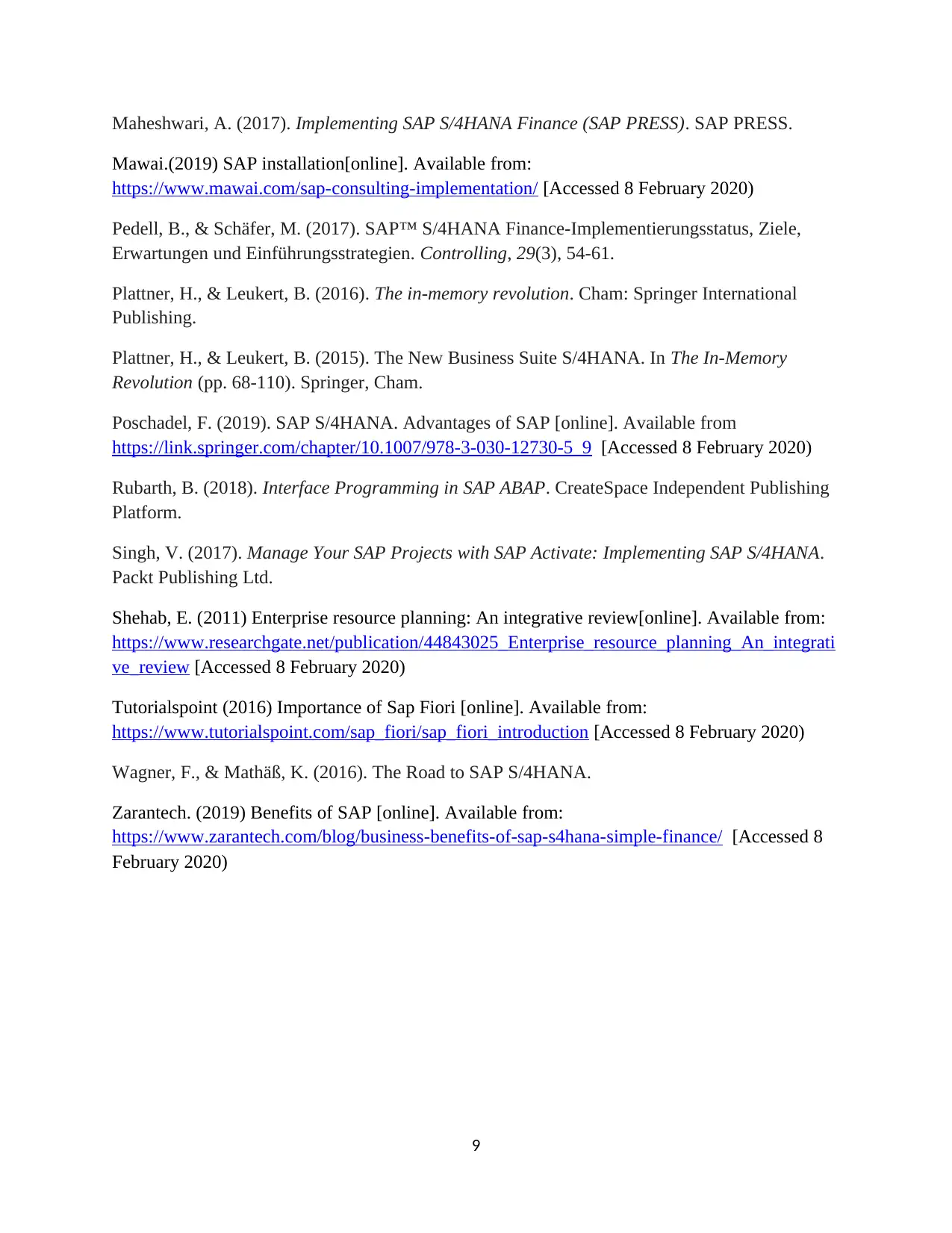
Maheshwari, A. (2017). Implementing SAP S/4HANA Finance (SAP PRESS). SAP PRESS.
Mawai.(2019) SAP installation[online]. Available from:
https://www.mawai.com/sap-consulting-implementation/ [Accessed 8 February 2020)
Pedell, B., & Schäfer, M. (2017). SAP™ S/4HANA Finance-Implementierungsstatus, Ziele,
Erwartungen und Einführungsstrategien. Controlling, 29(3), 54-61.
Plattner, H., & Leukert, B. (2016). The in-memory revolution. Cham: Springer International
Publishing.
Plattner, H., & Leukert, B. (2015). The New Business Suite S/4HANA. In The In-Memory
Revolution (pp. 68-110). Springer, Cham.
Poschadel, F. (2019). SAP S/4HANA. Advantages of SAP [online]. Available from
https://link.springer.com/chapter/10.1007/978-3-030-12730-5_9 [Accessed 8 February 2020)
Rubarth, B. (2018). Interface Programming in SAP ABAP. CreateSpace Independent Publishing
Platform.
Singh, V. (2017). Manage Your SAP Projects with SAP Activate: Implementing SAP S/4HANA.
Packt Publishing Ltd.
Shehab, E. (2011) Enterprise resource planning: An integrative review[online]. Available from:
https://www.researchgate.net/publication/44843025_Enterprise_resource_planning_An_integrati
ve_review [Accessed 8 February 2020)
Tutorialspoint (2016) Importance of Sap Fiori [online]. Available from:
https://www.tutorialspoint.com/sap_fiori/sap_fiori_introduction [Accessed 8 February 2020)
Wagner, F., & Mathäß, K. (2016). The Road to SAP S/4HANA.
Zarantech. (2019) Benefits of SAP [online]. Available from:
https://www.zarantech.com/blog/business-benefits-of-sap-s4hana-simple-finance/ [Accessed 8
February 2020)
9
Mawai.(2019) SAP installation[online]. Available from:
https://www.mawai.com/sap-consulting-implementation/ [Accessed 8 February 2020)
Pedell, B., & Schäfer, M. (2017). SAP™ S/4HANA Finance-Implementierungsstatus, Ziele,
Erwartungen und Einführungsstrategien. Controlling, 29(3), 54-61.
Plattner, H., & Leukert, B. (2016). The in-memory revolution. Cham: Springer International
Publishing.
Plattner, H., & Leukert, B. (2015). The New Business Suite S/4HANA. In The In-Memory
Revolution (pp. 68-110). Springer, Cham.
Poschadel, F. (2019). SAP S/4HANA. Advantages of SAP [online]. Available from
https://link.springer.com/chapter/10.1007/978-3-030-12730-5_9 [Accessed 8 February 2020)
Rubarth, B. (2018). Interface Programming in SAP ABAP. CreateSpace Independent Publishing
Platform.
Singh, V. (2017). Manage Your SAP Projects with SAP Activate: Implementing SAP S/4HANA.
Packt Publishing Ltd.
Shehab, E. (2011) Enterprise resource planning: An integrative review[online]. Available from:
https://www.researchgate.net/publication/44843025_Enterprise_resource_planning_An_integrati
ve_review [Accessed 8 February 2020)
Tutorialspoint (2016) Importance of Sap Fiori [online]. Available from:
https://www.tutorialspoint.com/sap_fiori/sap_fiori_introduction [Accessed 8 February 2020)
Wagner, F., & Mathäß, K. (2016). The Road to SAP S/4HANA.
Zarantech. (2019) Benefits of SAP [online]. Available from:
https://www.zarantech.com/blog/business-benefits-of-sap-s4hana-simple-finance/ [Accessed 8
February 2020)
9
⊘ This is a preview!⊘
Do you want full access?
Subscribe today to unlock all pages.

Trusted by 1+ million students worldwide
1 out of 9
Related Documents
Your All-in-One AI-Powered Toolkit for Academic Success.
+13062052269
info@desklib.com
Available 24*7 on WhatsApp / Email
![[object Object]](/_next/static/media/star-bottom.7253800d.svg)
Unlock your academic potential
Copyright © 2020–2025 A2Z Services. All Rights Reserved. Developed and managed by ZUCOL.





